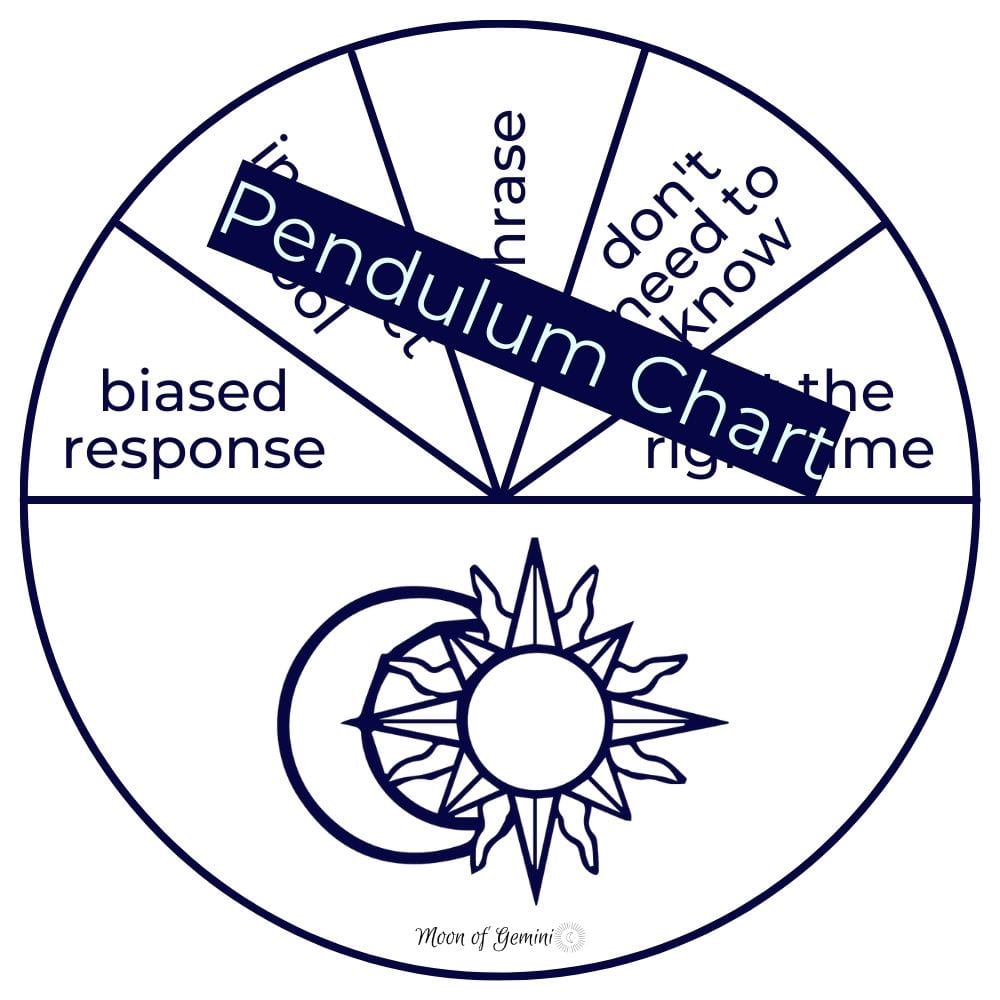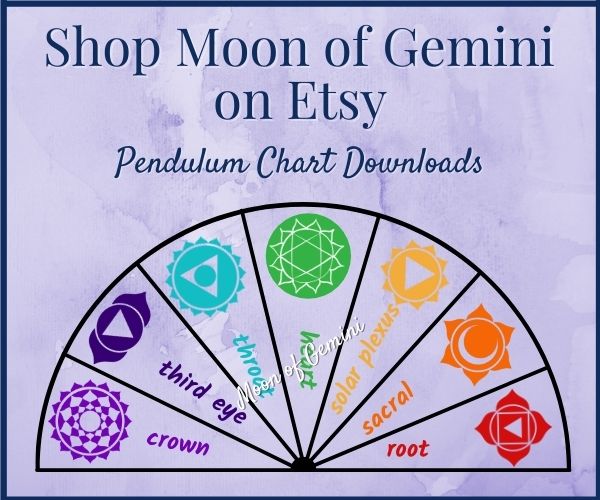This is an overview of how to ask your pendulums questions, what type of questions to ask, and what to remember while asking your pendulum questions! Further down on the page, there will also be a section dedicated to “what if your pendulum isn’t answering?” in a sort of troubleshooting guide to working with a pendulum!
This is specifically about asking questions to your pendulum; if you’re brand new or interested to learn more, read how to use a pendulum here or Pendulums 101!
*This post may include affiliate links. When you purchase items from these links, we will receive a small commission, at no extra cost to you, to help support this website. Thank you for your support! Read more ->
Asking your Pendulum Questions

Before talking about anything else, let’s start with how to ask questions to your pendulum. When I was just starting out, the books I found most helpful, and guided me in this topic Pendulum Mojo and How to use a Pendulum. Some of the ideas in phrasing that I still use are based on these readings.
1. Always start a reading or daily practice by asking “show me yes” and “show me no.” This warms up the pendulum, and gets you connected.
2. Next, ask the pendulum, “am I with a guide from the white light?” You can also ask if you are with an angel, or spirit, it’s really your preference. Just make sure to be working from white light. If you do not ask at the beginning of the reading, the answers could be coming from anywhere!
If you receive the answer “no” for working with a guide from the white light, STOP! Try clearing yourself of negativity. You can use the clearing method described here. Or meditate. But do not continue asking your pendulum questions if you are not working from the white light.
You may also want to read: Can anyone use a pendulum? Can someone use my pendulum?
Phrasing your questions correctly
Believe it or not, how you say something can affect your pendulum, much like it can affect people around you. I always phrase questions asked to my pendulum “all things considered, is it optimal…?” Starting with “all things considered” means that nothing is left to question. It’s considering everything. The second part of the question “is it optimal,” is important as well. Optimal means you will get the clearest answers.
Bad question examples:
“Should I do this?” Maybe you shouldn’t, but it could also be the optimal thing to do. By asking a question with “should,” you’re adding your own bias. And there’s an unknown factor to the answer.
Another bad way to phrase a question is with “can I.” You CAN do anything. But is it the optimal course of action? Maybe not. Stick with “all things considered, is it optimal…” instead!

Also, only ask one question at a time. You might think you’re asking one question, but it could be loaded full of question. For example, “all things considered, is it optimal for me to cut and dye my hair today?” has a lot of factors included. You might get a confusing answer from your pendulum.
Rather, ask “…to cut my hair,” “to dye my hair,” “cut my hair today,” “dye my hair today” as all different questions. Then you can get a full picture and clear answers.
Different methods for receiving answers from pendulums
There are many methods for getting answers from a pendulum. Some of the common ways include: yes/no questions, using charts, a pendulum board, retraining your pendulum, and using your hand, all described below! (Here‘s when I recommend using a chart)

Yes/No Questions
Yes/no is probably one of the most common ways to receive answers from your pendulum. You ask a yes/no question, and the pendulum moves in a direction for the response.
The direction can vary depending on which pendulum you use, so always ask your pendulum when getting to know it, what means yes, and what means no (I have 2 pendulums that move in a clockwise circle for yes, and one pendulum that moves up and down for yes, and all of my pendulums move side to side for no)!
This question asking method can be used for almost everything, if you have enough patience, even spelling out words by asking what each letter is and going through the letters while waiting for the pendulum to swing yes on the correct one.
Charts

I have a full post about when to use pendulum charts, you can find that here if you’d like more detail!
Charts are a great option for receiving answers from pendulums. You can purchase altar cloth charts, find them online, or make them yourself. Some have the letters of the alphabet on them, numbers, or even different options.
Using a chart, ask the pendulum to point (or swing) to the optimal answer, letter, number, etc. This can make the work a lot quicker if you have words to spell out or multiple options.
A chart I’ve made is for if your pendulum isn’t moving, it helps give you 5 ideas for why it isn’t! I’ve also created one for interviewing your pendulum! You can find a lot of free pendulum charts on Pinterest, for at least inspiration.
There is some discussion on whether it’s okay to use a chart that’s on your phone/technology, and if the technology interferes with the reading. I say try asking basic questions over a chart that’s on paper, and then a chart that’s on the technology, and see if the answers are the same, or if there is a problem.
Or, simply ask your pendulum if there will be a problem with using it over technology. It may also depend on what kind of pendulum you are using, a crystal, metal, or wooden one.
Using your Hand for Pendulum Questions
This is similar to using a chart for receiving answers from a pendulum, if there are 5 answers or less. Set an intention or idea for each finger on your hand, train your pendulum to go to that finger by swinging it that direction and saying what it is, then ask the question.
This works for questions like “which movie to see,” or like the chart above, each of those categories could be set to a finger rather than being on a chart. Be sure to write down what you’ve set each finger to mean, so that you don’t forget midway through a reading!
Retraining your Pendulum
The final way I’m going to discuss about asking questions to your pendulum is by retraining your pendulum. In this, you set a designated direction to mean one thing, and a direction to mean another. Confused by this?
Here’s a full article on programming your pendulum!
Say you’re testing chakras, and if there’s a blocked chakra. You could set your pendulum to swing one direction if there’s a blocked chakra, and not move at all if it’s clear. Or vice versa. Tell the pendulum how to swing for it, ask for it to demonstrate, and then use the pendulum to answer the questions (read more about this here: Chakra Test with a Pendulum).
What if my pendulum isn’t answering?
I’m confused! Why isn’t my pendulum answering the question? Let’s get into the “troubleshooting” your pendulum section now. If your pendulum isn’t answering any questions at all, look at this article instead: What to do When Your Pendulum isn’t Answering.
There are actually quite a few reasons why your pendulum might not be answering you, or might be moving in a direction that you don’t know what it means. I’ll try and discuss as many explanations as I know.

Troubleshooting
1. Make sure you’re using the right words in the question. This goes back to above, with using “all things considered, is it optimal…” as the way to start a question. Also, ensure the question is in yes/no form, and there are not extra bits added to the question. Your pendulum can only answer one question at a time! If it’s bombarded with alternatives, or multiple pieces in the question, try splitting it up into multiple questions.
2. There’s a chance your pendulum isn’t responding because of bias. If you’re getting no answer, and keep asking the question, you might be overwhelming the pendulum. Try to not ask the same question repeatedly, as your pendulum will eventually respond in just the way you want it to. Then you will not be receiving an intuitive answer.
3. Ask your pendulum to demonstrate what other things mean. Ask to show you what “neutral,” “not optimal to know that,” “ask again later,” and “not right now” look like. That might clue you in to what’s going on.
4. Alternatively, ask your pendulum, “all things considered, is it optimal for me to know ___?” If it responds yes, dig deeper “…for me to know right now?” Maybe you’re asking the question at the wrong time. If it is the wrong time, ask for further information about when it’s optimal to ask again. Ask if you can ask again in 3 months, 6 months, etc. It’s important to not force your pendulum to give you answers. You might not be ready to know, or it might not be optimal for you to know at all.
If your pendulum isn’t moving at all, here‘s an article for how to align with your pendulum to have it start moving again.
Bias
Mentioned above is bias. But bias needs a closer look, especially with the pendulum not acting the way you expect it to. With some questions, it can be really difficult to keep a bias out of your head.
When worrying about receiving a biased answer to your question, ask your pendulum “am I able to get an unbiased answer on this?” If the response is yes, try again. If the pendulum says no, try and clear your mind. Ask again, or ask later.
There are a few other ways to get an unbiased answer. Ranking in lowest level of relieving bias to the most extreme alternatives.
- Say “in an unbiased opinion, is it optimal for me to ____.” See what the answer is then.
- Close your eyes while asking the question and waiting for the pendulum to respond. Only open your eyes after the pendulum has begun swinging and see what it tells you.
- Ask someone else with a pendulum to ask the question for you.
- Write down yes and no on pieces of paper, or designate cards to be yes/no, mix them up thoroughly and then ask the pendulum to point to the answer for the question.
Have working with a pendulum down and are stuck on ideas on what to ask your pendulum or other uses for your pendulum? Find new ideas here! I hope this article has been helpful. Connect with me @moonofgemini on Instagram!



